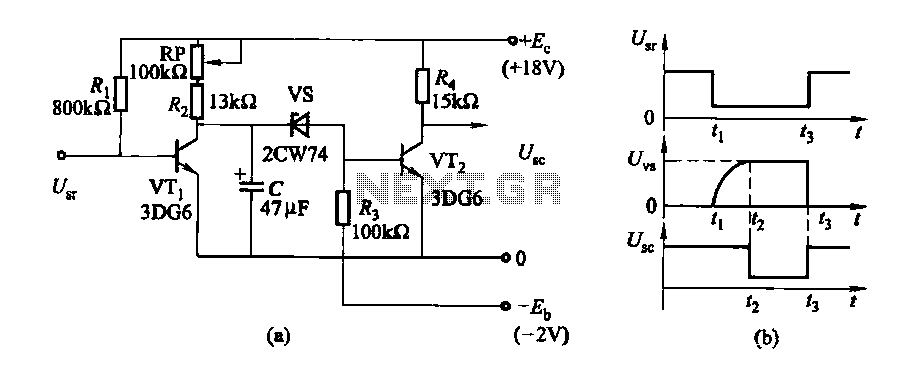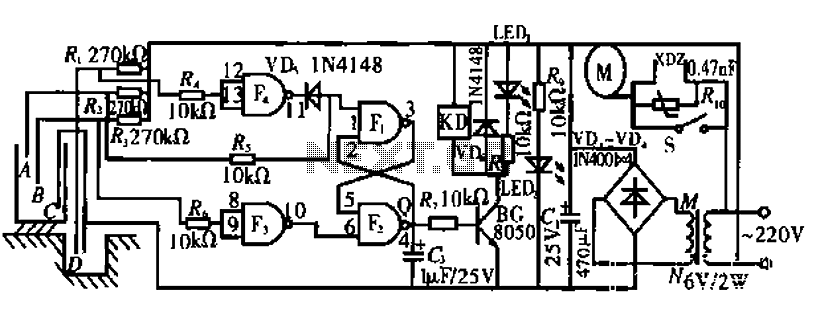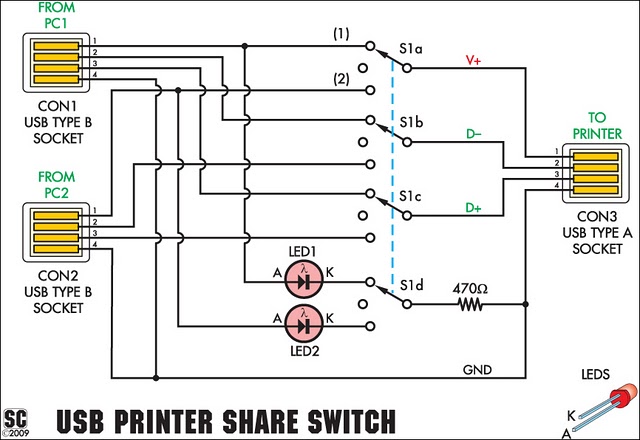
Single junction transistor pulse width trigger circuit

A conventional single junction transistor trigger circuit is limited to producing narrow pulses due to the rapid turn-off characteristics of the single-junction transistor. To address this limitation, a PNP transistor is added to the single-junction transistor trigger circuit, which allows for the widening of pulse width, as illustrated in Figure 169.
In this enhanced circuit design, the inclusion of a PNP transistor serves to extend the duration of the output pulse generated by the single junction transistor. The operation begins with the single junction transistor being triggered by an input signal. When the input signal is applied, the single junction transistor turns on, allowing current to flow through the circuit. However, due to its inherent characteristics, the single junction transistor quickly turns off when the input signal is removed, resulting in a narrow output pulse.
By integrating a PNP transistor into the circuit, the pulse width can be significantly increased. The PNP transistor is configured to respond to the output of the single junction transistor. When the single junction transistor is activated, it provides a biasing voltage to the base of the PNP transistor, turning it on. This configuration allows the PNP transistor to remain in the conducting state for a longer duration even after the single junction transistor has turned off, effectively stretching the pulse width.
The design must ensure that the biasing resistors for the PNP transistor are appropriately selected to control the turn-on and turn-off times. Capacitive elements may also be introduced to further shape the output pulse and control the timing characteristics. The final output pulse can be tailored to meet specific application requirements by adjusting these components.
Overall, this modification not only enhances the pulse width but also improves the versatility of the trigger circuit for various electronic applications, making it suitable for driving loads that require longer pulse durations. Proper simulation and testing should be conducted to validate the performance of the circuit before implementation in practical applications.Conventional single junction transistor trigger circuit can only be issued narrow pulse, the reason is because the single-junction transistor is turned quickly cut stop. To do this in a single-junction transistor trigger circuit adds a PNP transistor can be pulse width, the circuit shown in 169 in FIG.
In this enhanced circuit design, the inclusion of a PNP transistor serves to extend the duration of the output pulse generated by the single junction transistor. The operation begins with the single junction transistor being triggered by an input signal. When the input signal is applied, the single junction transistor turns on, allowing current to flow through the circuit. However, due to its inherent characteristics, the single junction transistor quickly turns off when the input signal is removed, resulting in a narrow output pulse.
By integrating a PNP transistor into the circuit, the pulse width can be significantly increased. The PNP transistor is configured to respond to the output of the single junction transistor. When the single junction transistor is activated, it provides a biasing voltage to the base of the PNP transistor, turning it on. This configuration allows the PNP transistor to remain in the conducting state for a longer duration even after the single junction transistor has turned off, effectively stretching the pulse width.
The design must ensure that the biasing resistors for the PNP transistor are appropriately selected to control the turn-on and turn-off times. Capacitive elements may also be introduced to further shape the output pulse and control the timing characteristics. The final output pulse can be tailored to meet specific application requirements by adjusting these components.
Overall, this modification not only enhances the pulse width but also improves the versatility of the trigger circuit for various electronic applications, making it suitable for driving loads that require longer pulse durations. Proper simulation and testing should be conducted to validate the performance of the circuit before implementation in practical applications.Conventional single junction transistor trigger circuit can only be issued narrow pulse, the reason is because the single-junction transistor is turned quickly cut stop. To do this in a single-junction transistor trigger circuit adds a PNP transistor can be pulse width, the circuit shown in 169 in FIG.





